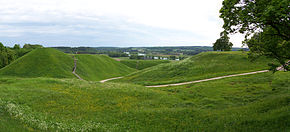Pajauta valley

One of the old hillfort mounds at Kernavė
|
|
| Location | Širvintos District Municipality, Lithuania |
|---|---|
| Coordinates | 54°53′N 24°51′E / 54.883°N 24.850°ECoordinates: 54°53′N 24°51′E / 54.883°N 24.850°E |
| Type | Settlement |
| History | |
| Abandoned | 14th century |
| Periods | Middle Ages |
| Cultures | Lithuanian |
| Site notes | |
| Excavation dates | 1859, 1979, 1980–1983 |
| Condition | In ruins |
| UNESCO World Heritage Site | |
| Official name | Kernavė Archaeological Site (Cultural Reserve of Kernavė) |
| Criteria | Cultural: (iii), (iv) |
| Reference | 1137 |
| Inscription | 2004 (28th Session) |
|
[]
|
|
Kernavė was a medieval capital of the Grand Duchy of Lithuania and today is a tourist attraction and an archeological site (population 318, 1999). It is located in the Širvintos district municipality located in southeast Lithuania. A Lithuanian state cultural reserve was established in Kernavė in 1989. In 2004 Kernavė Archaeological Site was included into UNESCO world heritage list.
Kernavė is a small town in the southeaster part of Lithuania, in Širvintos district, located on the right bank of the river Neris, on the upper Neris terrace. It is 21 kilometers (13 mi) distance from Širvintos and 35 kilometers (22 mi) from Vilnius. It is close to the Vilnius-Kaunas (18 km or 11 mi) and Vilnius-Panevėžys (17 km or 11 mi) highways. It is possible to travel to Kernavė from Vilnius by the river Neris.
Its alternate names include Kernavos, Kernovo, Kiernowo, Kiernów (Polish), and Kernuvke (Yiddish).
The area of Kernavė was sparingly inhabited at the end of the Paleolithic era, with the number of settlements significantly increasing in the Mesolithic and Neolithic eras.
The town was first mentioned in 1279, when, as the capital of the Grand Duke Traidenis, it was besieged by the Teutonic Knights. In 1390, during the Lithuanian Civil War (1389–1392), the knights burned the town and its buildings in the Pajauta valley, including the castle. After this raid, the town wasn't rebuilt, and the remaining residents moved to the top of the hill instead of staying in the valley.
...
Wikipedia

